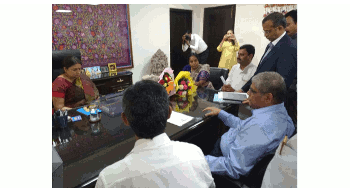
Industry’s SOS on cotton crisis
The predominantly cotton based Indian textile industry has been facing acute crisis during the last eight years due to high volatility in cotton prices especially during off season starting from May to September.
The predominantly cotton based Indian textile industry has been facing acute crisis during the last eight years due to high volatility in cotton prices especially during off season starting from May to September. Though the cotton year is October to September, more than 80 per cent of the cotton arrives the market during November to March. Due to financial constraints and three months credit limit facility extended by the banks, spinning mills are forced to procure high cost cotton for at least five months. The stagnated growth in the cotton textile industry and exports is caused mainly due to volatility in cotton prices.
The industry has been pleading the Central Government to announce cotton fibre security policy since 2007 after the removal of cotton from Essential Commodities Act by extending a low cost working capital fund and ensure adequate stock to use ratio of cotton to have a level playing field in the globalised environment. So far no decision has been taken by the Centre.
Against this background, a 19-member delegation led by Vanathi Srinivasan, State General Secretary, BJP, Tamil Nadu and M.Senthilkumar, Chairman, Southern India Mills’ Association (SIMA) met the nion Textile Minister, Smriti Zubin Irani recently and submitted a joint memorandum.
M Senthilkumar has stated that based on the collective decision taken by 26 textile Associations across the value chain in the country, it was unanimously decided to insist the government to direct Cotton Corporation of India to procure 70 to 80 lakh bales of cotton during peak season when the Indian cotton price rules lower than the international price, retain cotton as buffer stock and sell this quantity only to the actual users during May to September.
Senthilkumar has stated that the delegation included representatives from SIMA, Northern India Textile Mills’ Association (NITMA), Rajasthan Textile Mills’ Association (RTMA), Tamil Nadu Spinning Mills Association (TASMA), South India Spinners’ Association (SISPA), Indian Texpreneurs Federation (ITF), Tirupur Exporters’ Association (TEA), Powerloom Development & Export Promotion Council (PDEXIL), Andhra Pradhesh Spinning Mills Association, All India Spinning Mills Association, Tamil Nadu Open End Spinning Mills Association, All Gujarat Spinners’ Association.
He has stated that cotton fibre security is very essential as more than 80 per cent of the textile manufacturing units are in the MSME category which provides 35 million jobs directly, particularly for the poor masses of the Nation. He has stated that the cotton price which was Rs 33,000 per candy of 355 kg reached almost Rs 50,000 per candy during July 2016 thus increasing the clean cotton price up to Rs.65 per kg while the yarn price increased only by Rs 20 to Rs 30 per kg thus making the spinning mills to incur Rs 20 to Rs 25 per kg loss during the last three months and several hundreds of mills had to cut down production from 20 to 35 per cent throwing lakhs of people out of jobs. He has said that the downstream sectors such as handlooms, powerlooms and apparel also incurred huge losses and there was a decline in the export of cotton textiles.
Senthilkumar has stated that Indian cotton textile industry is already facing severe recession due to the tariff barriers and sluggish demand for cotton yarn in the domestic and export markets. Under such scenario, the high volatility in cotton price has made several hundreds of spinning mills unviable and NPAs.
SIMA Chairman has stated that the Union Textile Minister has highly responded to the joint memorandum submitted by pan India textile delegation and immediately directed the officials to study the possibility of implementing the proposed scheme in the forthcoming season. Senthilkumar has once again appealed to the Central Government to come out with cotton fibre security policy which is a long pending agenda and curtail the volatility in cotton prices from the coming season onwards. He has also appealed to the Centre to ensure adequate stock-to-use ratio of 25 per cent which is currently 12 to 15 per cent in India as against world average of 91 per cent including China and 54 per cent excluding China.
CATEGORIES Industry Update



